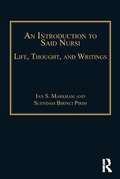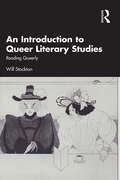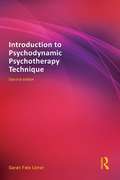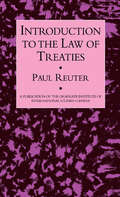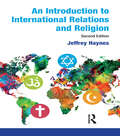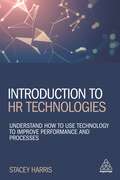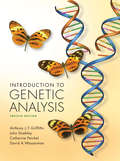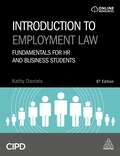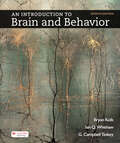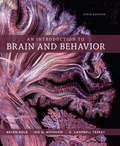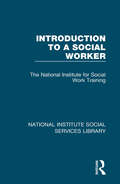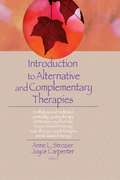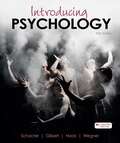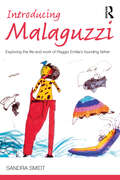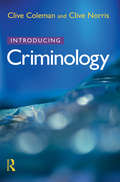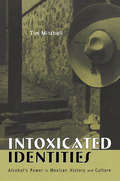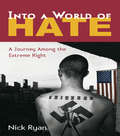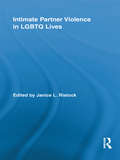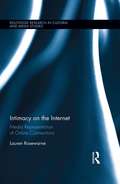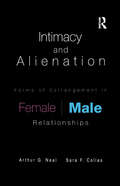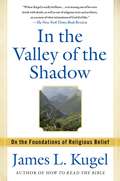Special Collections
Benetech’s Global Certified Accessible Titles
Description: Benetech’s GCA program is the first independent third-party EPUB certification to verify ebook accessibility. By creating content that is born accessible, publishers can meet the needs of all readers. Learn more: https://bornaccessible.benetech.org/
- Table View
- List View
An Introduction to the French Poets
by Geoffrey BreretonThe French poetry of some five centuries is here surveyed in a series of studies of the work and personality of individual poets from Villon to the present day. Each chapter is primarily concerned with establishing the ‘literary identity’ of the poet or poets with whom it deals: the work of each is outlined and related to the historical and biographical circumstances in which it was written; and its characteristics are then examined critically in terms relevant to the modern reader. Comparisons are made between different poets, and more general topics – such as the concepts of ‘classic’ and ‘baroque’ – are discussed. This book, first published in 1956, had become a standard introductory work for students of French poetry and general readers alike. For this revised edition, originally published in 1973, new chapters have been added on ‘irregular’ seventeenth-century poets and on various modern poets whose work now enables the Surrealist movement to be seen in clearer perspective. The bibliography has been revised extensively.
An Introduction to Studying Popular Culture
by Dominic StrinatiHow can we study popular culture? What makes 'popular culture' popular? Is popular culture important? What influence does it have?An Introduction to Studying Popular Culture provides a clear and comprehensive answer to these questions. It presents a critical assessment of the major ways in which popular culture has been interpreted, and suggests how it may be more usefully studied.Dominic Strinati uses the examples of cinema and television to show how we can understand popular culture from sociological and historical perspectives.
An Introduction to Said Nursi
by Ian S. Markham and Suendam Birinci PirimContemporary Islamic thinkers are often studied sociologically rather than as theologians. There are many accessible introductions to Christian theologians, but very few such studies of Islamic thinkers. This book, and this series, seeks to change this situation: offering new introductions to influential Islamic thinkers and engaging, at the level of ideas, with the rich depths of contemporary Islamic theology. This book introduces to the English-speaking world the leading modern Islamic thinker Said Nursi (1878-1960) - who has some nine million followers in modern day Turkey and around the world. After an opening chapter that provides an overview of his life, the next four chapters outline the theology of Nursi on God, the Qur'an, the West and Politics. The final section provides an invaluable resource of readings from Nursi's most important writings. Providing an introduction to a major form of Islam which is committed to non-violence, dialogue and constructive relationships with the West, this is the first student textbook to introduce a contemporary Islamic theologian in a systematic way.
An Introduction to Queer Literary Studies
by Will StocktonAn Introduction to Queer Literary Studies: Reading Queerly is the first introduction to queer theory written especially for students of literature. Tracking the emergence of queer theory out of gay and lesbian studies, this book pays unique attention to how queer scholars have read some of the most well-known works in the English language. Organized thematically, this book explores queer theoretical treatments of sexual identity, gender and sexual norms and normativity, negativity and utopianism, economics and neoliberalism, and AIDS activism and disability. Each chapter expounds upon foundational works in queer theory by scholars including Michel Foucault, Eve Kosofsky Sedgwick, and Lee Edelman. Each chapter also offers readings of primary texts –ranging from the highly canonical, like John Milton’s Paradise Lost, to more contemporary works of popular fiction, like Stephen King’s ’Salem’s Lot. Along the way, An Introduction to Queer Literary Studies: Reading Queerly demonstrates how queer reading methods work alongside other methods like feminism, historicism, deconstruction, and psychoanalysis. By modelling queer readings, this book invites literature students to develop queer readings of their own. It also suggests that reading queerly is not simply a matter of reading work written by queer people. Queer reading attunes us to the queerness of even the most straightforward text.
Introduction to Psychodynamic Psychotherapy Technique
by Sarah Fels UsherIntroduction to Psychodynamic Psychotherapy Technique is a revised edition of the popular technical guide to the conduct of psychodynamic psychotherapy written by Sarah Fels Usher, published in 1993. In her thoroughly updated book, the author takes the student from the very beginning through to the end of the processes involved in using psychodynamic psychotherapy as a method of understanding and treating patients. Introduction to Psychodynamic Psychotherapy Technique offers explanations of how psychoanalytic/psychodynamic theory underwrites the technique, and demonstrates how the technique follows from the theory in a clear and accessible style. Each chapter is organized around the psychoanalytic concepts of transference and counter-transference, demonstrating how these concepts bring the work together. New material includes a chapter devoted to working with patients’ defenses, an in-depth look at the emotions on both sides during termination, and a chapter on the experience of supervision, all accompanied by lively clinical examples. The book is unique in that it is written from the point of view of the student, highlighting the difficulties they may encounter in practice and offering concrete suggestions for technique. Introduction to Psychodynamic Psychotherapy Technique will be of interest to psychoanalysts, psychotherapists, psychiatric residents, graduate psychotherapy students and social work students.
Introduction To The Law Of Treat
by ReuterFirst Published in 1995. Routledge is an imprint of Taylor & Francis, an informa company.
An Introduction to Jean-Yves Lacoste
by Joeri SchrijversIntroducing the thought of philosopher and theologian Jean-Yves Lacoste, this book provides an overview spanning Lacoste's earliest works on sacramentality to his latest work Etre en Danger (2011) in which Lacoste opens up the liturgical experience onto a spiritual experience of life. Schrijvers unfolds the logic of what Lacoste calls 'the liturgical experience' from its violent variety in Expérience et Absolu to the logic of love and love's possibility as it is developed in the later works. Throughout the book, the focus is on Lacoste's dialogue with Heidegger and through this his attempt to widen the scope of phenomenology to include the phenomenality of the divine.
An Introduction to International Relations and Religion
by Jeffrey HaynesNot so very long ago it seemed reasonable to assert that the influence of religion on global politics was on the wane. As the Western world became increasingly secular and the process of globalisation deepened, it seemed inevitable - on the surface at least - that the voice of religion was to be heard softly if it was to be heard at all. This has now changed, and changed perhaps irrevocably. As Jeff Haynes argues in this thought-provoking and important new book, various religious 'actors' are now significantly involved in international relations and have become a crucial influence on policy in a post-Westphalian world. International Relations and Religion guides the reader through the complex issues at the heart of this topic with clarity and insight. This updated second edition starts with a close reading of the many theoretical and analytical concepts - notably Huntington and the clash of civilisations - that have grown up around this area and then concludes with a summary of the issues under discussion and attempts to put into context what it means to live in a world that is increasingly shaped by a whole host of diverse religious groups. Essential reading for students of International Relations and Politics.
Introduction to HR Technologies
by Stacey HarrisTechnology can have huge benefits for the HR function. Whether it's saving time by streamlining processes, boosting engagement by enabling analysis of people data or improving employee development by allowing staff to access the content they need on different platforms, wherever and whenever they need it; the opportunities are vast. However, with more apps, software and platforms than ever before, the volume and variety of available technologies can be overwhelming. This makes it extremely difficult for HR professionals to know where to start when assessing what technologies are out there and which are worth investing in. Introduction to HR Technologies addresses these issues in clear, accessible and jargon-free language and is an indispensable guide for HR professionals needing to get to grips with technologies and understand how to use them to add tangible business value. Covering all the core areas of HR including recruitment, performance management, learning and development (L&D) and reward, Introduction to HR Technologies allows practitioners to identify areas where technologies can be used to drive performance and what to look for when assessing technological solutions. There is also discussion of artificial intelligence (AI), machine learning and the Internet of Things (IoT) and what they mean for HR. This book is essential reading for all HR professionals looking to use technology confidently to increase performance, improve processes and add value to both employees and the business as a whole.
Introduction to Genetic Analysis
by Anthony Griffiths and John Doebley and Catherine Peichel and David WassarmanThe new 12th edition of Introduction to Genetic Analysis takes this cornerstone textbook to the next level. The hallmark focus on genetic analysis, quantitative problem solving, and experimentation continues in this new edition. The 12th edition also introduces SaplingPlus, the best online resource to teach students the problem solving skills they need to succeed in genetics. SaplingPlus combines Sapling’s acclaimed automatically graded online homework with an extensive suite of engaging multimedia learning resources.
Introduction to Fourier Optics
by Joseph GoodmanFourier analysis is a ubiquitous tool that has found application to diverse areas of physics and engineering. Goodman focuses on applications in optics, and in particular with applications to diffraction, imaging, optical information processing, holography, and optical communications. Goodman, Introduction to Fourier Optics satisfies the needs of several different types of Physics and Engineering courses. Directed towards both physicists and engineers this text is suitable for audiences focusing on applications of optics. A clear presentation makes this text work well as both a teaching resource and a reference book.
Introduction to Employment Law
by Kathy DanielsWritten specifically for HR and business students, Introduction to Employment Law is a clear, accessible and jargon-free guide to UK employment law and how it applies in practice. This book covers all the essentials of employment law including employment contracts, discrimination, redundancy and employment tribunals. There is also expert guidance on key issues including shared parental leave, flexible working policies and protected characteristics. Fully revised with the latest cases and legal developments, this new edition includes coverage of the rights of agency workers, bereavement leave, furlough practices and the legal implications of Brexit. This textbook doesn't assume any prior knowledge of the UK legal system and equips students with the knowledge and skills that they need to take forward into the workplace. Packed with pedagogical features to consolidate learning including tasks, examples, explore further sections and key learning points as well as a dedicated study skills chapter covering employment law assignments and exams, Introduction to Employment Law is essential reading for all students studying the CIPD Level 5 Intermediate module in employment law. It is also an accessible introduction for Level 7 students and those on undergraduate and postgraduate business courses needing a thorough grounding in employment law. Online resources include lecture slides, case studies, annotated weblinks and an instructor's manual.
An Introduction to Brain and Behavior
by Bryan Kolb and Ian Whishaw and G. TeskeyThe new edition of An Introduction to Brain & Behavior takes you the frontiers of the study and practice of behavioral neuroscience.
An Introduction to Brain and Behavior
by Bryan Kolb and Ian Whishaw and G. TeskeyFrom authors Bryan Kolb, Ian Whishaw, and G. Campbell Teskey, An Introduction to Brain and Behavior offers a unique inquiry-based approach to behavioral neuroscience with each chapter focusing on a central question (i.e., How Does the Nervous System Function?). The authors emphasize a distinctive clinical perspective, with examples that show students what happens when common neuronal processes malfunction. The new edition continues the Brain and Behavior tradition of incorporating the latest research throughout the book. Revisions include new material discussing current research on genetic mosaics and modification, including transgenic techniques and optogenetic techniques, neurotransmitters, hormones, brain development in adolescence, psychobiotics, color perception, and biorhythms, as well as updates to the discussion of specific disorders to reflect the current state of understanding, including Parkinson’s disease, Alzheimer’s disease, depression and drug dependency, sleep disorders, schizophrenia, glaucoma, and abnormal development related to prenatal experience.
Introduction to a Social Worker
by The National Institute for Social Work TrainingOriginally published in 1964, this was an introduction to social casework, that is social work with individuals and families. It was written for students at the beginning of their training and, while intended for the social worker, it would also prove useful to other students of the social sciences and interesting to the ordinary citizen who wanted to know what social work could offer either to people in trouble or to those who adopted it as a career. The book was both authoritative and up-to-date at the time, in a field in which methods of training had evolved quite rapidly. To this its origin bears witness: the preparatory work was done by Miss Florence Mitchell, an experienced social worker and teacher of social casework. The book was shaped in consultation with other practitioners and teachers, including Dr Younghusband and Miss K. M. Lewis of the National Institute whose work had done so much to shape modern methods of training. The first chapter gives a picture of people who need the social worker’s help. It is followed by a brief survey of methods, by three chapters of case studies and by a final chapter on social work in the social services. The book thus combines a philosophy with practical guidance.
Introduction to Alternative and Complementary Therapies
by Terry S Trepper and Anne Strozier and Joyce E Carpenter and Lorna L HeckerDiscover creative new ways to facilitate the therapeutic process Therapeutic modalities that psychotherapists usually rely on--such as psychodynamic, humanistic, systems, cognitive, narrative, analytic and solution focused--are all verbal interventions. Introduction to Complementary and Alternative Therapies presents a comprehensive overview of complementary and alternative therapeutic interventions that go beyond the standard verbal approaches. The therapies presented in this book--including mindfulness and meditation, spirituality, poetry therapy, art therapy, psychodrama, dance/movement therapy, music therapy, animal-assisted therapy, and touch therapy--provide the reader with creative non-traditional modalities that are effective in conjunction with traditional treatment, or as substitutes. They may enrich talk-therapy, especially when therapists and/or clients get stuck, or they may provide healing on their own. Introduction to Complementary and Alternative Therapies explains the basics about how these nontraditional therapies work and provides vivid examples for utilizing them in treatment. Each chapter is written by an expert in the field of expertise, and includes a description of the approach, research evidence about its effectiveness, guidelines on how to use the therapy in practice, and case examples. This excellent volume also provides practitioners with a wide range of resources, including Web sites, information on state and national organizations, accrediting board info, and more. Topics in Introduction to Complementary and Alternative Therapies include: the mind-body relationship ways to integrate spirituality in counseling the healing components of poetry research studies on art therapy different techniques available in Psychodrama using body movement as a means of expressing conflicts and desires how music therapy promotes positive changes in the client the healing aspects of animals and much more! Introduction to Complementary and Alternative Therapies is a horizon-expanding guide for therapists, social workers, psychologists, counselors, physicians, educators, and students.
Introducing Psychology
by Daniel Gilbert and Daniel Schacter and Daniel Wegner and Matthew NockWith Macmillan’s superior content delivered by LaunchPad (comprehensive course) or Achieve Read & Practice (e-book + online homework), Introducing Psychology keeps students turning the pages and fully engaged online. The remarkable author team (each an accomplished teacher and scientist; three of them popular general interest writers) introduce psychology’s scientific foundations with offbeat, example-rich writing and engrossing online activities that make this anything but a typical textbook. Shaped by the authors’ ongoing research and user feedback, the thoroughly updated new edition centers on the theme, “For the love of science,” and offers more study support with new Learning Outcomes LaunchPad for this edition includes the popular Data Visualization Activities—a unique resource for building students’ quantitative reasoning skills.
Introducing Malaguzzi
by Sandra SmidtLoris Malaguzzi is recognised as the founder of the extraordinary programmes of preschool education that developed after the war in Reggio Emilia, Italy. Deeply embedded in the cultures and communities they serve, these unique preschools have justifiably become famous throughout the world. In this accessible and engaging text, Sandra Smidt examines how Malaguzzi’s philosophy developed out of his personal experiences of growing up in post-fascist Italy. His ideas are explored and illustrated throughout by examples relating to everyday early years practice. The key themes explored include: relationships — the importance of relationships, culture and contexts to learning within any setting and beyond; transparency — the importance of listening and documentation to understanding and sharing learning; questioning — inviting children to not only answer questions but raise them, allowing them to be equal partners in all learning situations; creativity — finding ways of enabling children to use all the expressive languages they can find to express and share their ideas; equity and fairness — involving the community in all decision-making and discussions, to ensure that early childhood education is accessible and relevant to all children.? This book will be of benefit to all those working with young children and essential reading for students on early childhood education programmes.
Introducing Criminology
by Clive Norris and Clive ColemanCriminology, or the study of crime, has developed rapidly as a subject in recent years, while crime and the problem of how to respond to it have become major concerns for society as a whole. This book provides a succinct, highly readable - and much needed - introduction to criminology for those who want to learn more, whether they are already studying the subject, thinking of doing so, or just interested to discover what criminology is about. Introducing Criminology begins by asking basic questions: what is crime? what is criminology?, before examining the ways in which crime has been studied, and looking at the main approaches and schools of thought within criminology and how these have been developed. The authors focus particularly upon attempts to understand and explain crime by the disciplines of psychology and sociology, and consider also the impact of feminist and postmodern thought on the development of the subject. In the second part of the book the authors take three very different topics to illustrate themes raised in the first half of the book, exploring the particular issues raised by each topic, and showing how criminologists have gone about their work.
Intoxicated Identities
by Tim MitchellFirst Published in 2004. Routledge is an imprint of Taylor & Francis, an informa company.
Into a World of Hate
by Nick RyanNick Ryan spent six arduous years traveling amongst a huge array of right-wing extremists. Winning the trust of the men and women at the heart of these movements - from bombers to presidential candidates, across Europe and the USA - Into A World Of Hate is the tale of his gripping odyssey.
Intimate Partner Violence in LGBTQ Lives
by Janice L. RistockQueer lives remain at the margins of most academic inquiry into domestic violence. When same-sex violence is considered, it is most commonly as an "added on," without close attention to the specificity and meaning of violence within the lives of lesbian/ gay/ bisexual/ transgender/Two-Spirit and queer people (LGBTQ). This edited volume seeks to change this discourse by bringing together the most innovative research about intimate partner violence that is specific to the lives of LGBTQ people. Including contributions based on research conducted in the United States, the United Kingdom, Canada and Australia, the volume is framed around central themes: conceptualizing violence; exploring differing spaces and lived experiences of violence; and the ethical challenges of responding to violence. The contributors also consider issues of race, class, gender, sexuality and other social differences, moving beyond a simple gender lens to one involving a framework of intersectionality.
Intimacy on the Internet
by Lauren RosewarneThe focus of this book is on the media representations of the use of the Internet in seeking intimate connections—be it a committed relationship, a hook-up, or a community in which to dabble in fringe sexual practices. Popular culture (film, narrative television, the news media, and advertising) present two very distinct pictures of the use of the Internet as related to intimacy. From news reports about victims of online dating, to the presentation of the desperate and dateless, the perverts and the deviants, a distinct frame for the intimacy/Internet connection is negativity. In some examples however, a changing picture is emerging. The ubiquitousness of Internet use today has meant a slow increase in comparatively more positive representations of successful online romances in the news, resulting in more positive-spin advertising and a more even-handed presence of such liaisons in narrative television and film. Both the positive and the negative media representations are categorised and analysed in this book to explore what they reveal about the intersection of gender, sexuality, technology and the changing mores regarding intimacy.
Intimacy and Alienation
by Arthur G. Neal and Sara F. CollasFirst published in 2000. Routledge is an imprint of Taylor & Francis, an informa company.
In the Valley of the Shadow
by James L. KugelTEN YEARS AGO, Harvard professor James Kugel was diagnosed with an aggressive, likely fatal, form of cancer. "I was, of course, disturbed and worried. But the main change in my state of mind was that the background music had suddenly stopped--the music of daily life that's constantly going, the music of infinite time and possibilities. Now suddenly it was gone, replaced by nothing, just silence. There you are, one little person, sitting in the late summer sun, with only a few things left to do." Despite his illness, Kugel was intrigued by this new state of mind and especially the uncanny feeling of human smallness that came with it. There seemed to be something overwhelmingly true about it--and its starkness reminded him of certain themes and motifs he had encountered in his years of studying ancient religions. "This, I remember thinking, was something I should really look into further--if ever I got the chance." In the Valley of the Shadow is the result of that search. In this wide-ranging exploration of different aspects of religion--interspersed with his personal reflections on the course of his own illness--Kugel seeks to uncover what he calls "the starting point of religious consciousness," an ancient "sense of self" and a way of fitting into the world that is quite at odds with the usual one. He tracks these down in accounts written long ago of human meetings with gods and angels, anthropologists' descriptions of the lives of hunter-gatherers, the role of witchcraft in African societies, first-person narratives of religious conversions, as well as the experimental data assembled by contemporary neuroscientists and evolutionary biologists. Though this different sense of how we fit into the world has largely disappeared from our own societies, it can still come back to us as a fleeting state of mind, "when you are just sitting on some park bench somewhere; or at a wedding, while everyone else is dancing and jumping around; or else one day standing in your backyard, as the sun streams down through the trees . . . " Experienced in its fullness, this different way of seeing opens onto a stark, new landscape ordinarily hidden from human eyes. Kugel's look at the whole phenomenon of religious beliefs is a rigorously honest, sometimes skeptical, but ultimately deeply moving affirmation of faith in God. One of our generation's leading biblical scholars has created a powerful meditation on humanity's place in the world and all that matters most in our lives. Believers and doubters alike will be struck by its combination of objective scholarship and poetic insight, which makes for a single, beautifully crafted consideration of life's greatest mystery.


